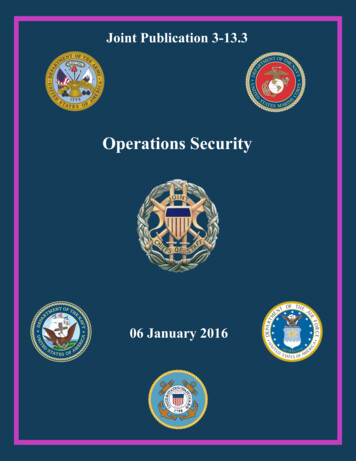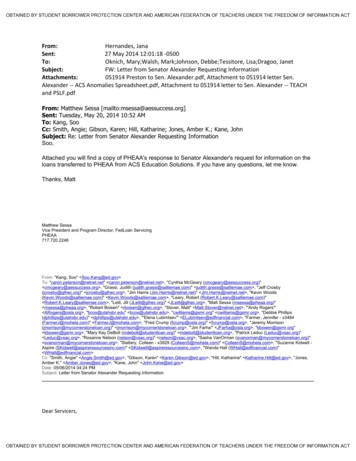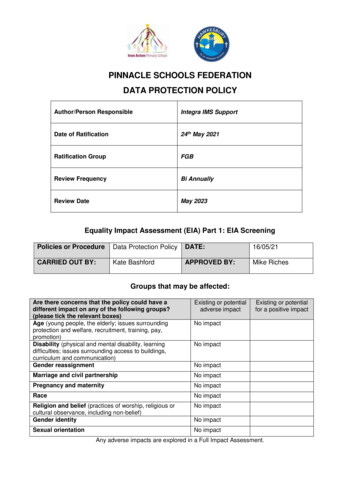
Transcription
ENTTMHIT OF T HS W E' L LDEFEENDARDSTMTEERU NII CA MY DE PARJoint Publication 3-13.3AT E S O FAOperations Security06 January 2016
PREFACE1. ScopeThis publication provides joint doctrine to plan, execute, and assess operationssecurity within joint operations and activities.2. PurposeThis publication has been prepared under the direction of the Chairman of the JointChiefs of Staff. It sets forth joint doctrine to govern the activities and performance of theArmed Forces of the United States in joint operations, and it provides considerations formilitary interaction with governmental and nongovernmental agencies, multinationalforces, and other interorganizational partners. It provides military guidance for theexercise of authority by combatant commanders and other joint force commanders(JFCs), and prescribes joint doctrine for operations and training. It provides militaryguidance for use by the Armed Forces in preparing and executing their plans and orders.It is not the intent of this publication to restrict the authority of the JFC from organizingthe force and executing the mission in a manner the JFC deems most appropriate toensure unity of effort in the accomplishment of objectives.3. Applicationa. Joint doctrine established in this publication applies to the joint staff, commandersof combatant commands, subunified commands, joint task forces, subordinatecomponents of these commands, and the Services, and combat support agencies.b. The guidance in this publication is authoritative; as such, this doctrine will befollowed except when, in the judgment of the commander, exceptional circumstancesdictate otherwise. If conflicts arise between the contents of this publication and thecontents of Service publications, this publication will take precedence unless theChairman of the Joint Chiefs of Staff, normally in coordination with the other membersof the Joint Chiefs of Staff, has provided more current and specific guidance.Commanders of forces operating as part of a multinational (alliance or coalition) militarycommand should follow multinational doctrine and procedures ratified by the UnitedStates. For doctrine and procedures not ratified by the US, commanders should evaluateand follow the multinational command’s doctrine and procedures, where applicable andconsistent with US law, regulations, and doctrine.For the Chairman of the Joint Chiefs of Staff:WILLIAM C. MAYVILLE, JR.LTG, USADirector, Joint Staffi
PrefaceIntentionally BlankiiJP 3-13.3
SUMMARY OF CHANGESREVISION OF JOINT PUBLICATION 3-13.3DATED 04 JANUARY 2012 Restructures document format, rearranging information within chapters forbetter sequencing and flow while reducing redundancy. Updates definitions of operations security (OPSEC) and OPSEC indicators. Adds section in OPSEC overview on cyberspace, highlighting the keyvulnerabilities associated with Internet use, to include social media,geotagging, data mining, and posting of contracting information on theInternet. Adds OPSEC planner to OPSEC responsibilities section, stressing theimportance a trained OPSEC planner will have on protecting both the planand the planning process. Adds quantitative and qualitative examples of both measurement ofeffectiveness and measurement of performance during the application ofOPSEC countermeasures. Adds combatant command red teams as a factor to consider employing tosupport OPSEC planning, execution, and assessment. Expands on the relationship between OPSEC and military deception duringthe planning process and defines the use of deception in support of OPSECas an OPSEC countermeasure. Restructures OPSEC assessment planning, execution, and analysis andreporting sections and adds Department of Defense 5205.02-M, DODOperations Security (OPSEC) Program Manual, as reference for the conductof OPSEC assessments and surveys, ensuring consistency in annualassessments. Updates Appendix C, “Sample Operations Security Plan,” to reflect currencywith Chairman of the Joint Chiefs of Staff Manual 3130.03, AdaptivePlanning and Execution (APEX) Planning Formats and Guidance. Updates references, acronyms, and terminology consistent with other jointdoctrine.iii
Summary of ChangesIntentionally BlankivJP 3-13.3
TABLE OF CONTENTSEXECUTIVE SUMMARY . viiCHAPTER IOPERATIONS SECURITY OVERVIEW Policy . I-1Operational Context . I-1Purpose of Operations Security . I-2Operations Security and Intelligence . I-3Characteristics of Operations Security. I-4Operations Security and Information Operations . I-4Operations Security and Cover . I-5Operations Security and Cyberspace . I-5Operations Security Responsibilities . I-7CHAPTER IITHE OPERATIONS SECURITY PROCESS General .II-1Identify Critical Information .II-1Threat Analysis .II-2Vulnerability Analysis .II-4Risk Assessment .II-4Apply Operations Security Countermeasures .II-6CHAPTER IIIOPERATIONS SECURITY PLANNING General . III-1Operations Security Factors . III-1Operations Security Indicators. III-4Operations Security Countermeasures . III-7Operations Security Process in Planning . III-10Planning Coordination . III-11Joint and Interagency Planning . III-12Multinational Planning. III-12Intergovernmental and Nongovernmental Organization Considerations . III-13CHAPTER IVOPERATIONS SECURITY ASSESSMENTS AND SURVEYS Assessments and Surveys . IV-1Assessment Planning . IV-4Assessment Execution . IV-5Analysis and Reporting . IV-5v
Table of ContentsAPPENDIXABCDEOperations Security Indicators . A-1Functional Outlines and Profiles .B-1Sample Operations Security Plan .C-1References . D-1Administrative Instructions . E-1GLOSSARYPart IPart IIAbbreviations and Acronyms . GL-1Terms and Definitions . GL-3FIGUREII-1II-2IV-1viThe Operations Security Process.II-2Examples of Critical Information .II-3Assessment–Survey Comparison . IV-4JP 3-13.3
EXECUTIVE SUMMARYCOMMANDER’S OVERVIEW Provides a General Overview of Operations Security Identifies Operations Security Responsibilities Describes the Operations Security Process Explains Operations Security Planning Discusses Operations Security Assessments and SurveysOperations Security OverviewOperational ContextJoint forces often displaypersonnel, organizations, assets,and actions to public view and toa variety of adversary intelligencecollection activities, includingsensors and systems.Commandersensureoperationalsecurity(OPSEC) is practiced during all phases ofoperations. OPSEC is a capability that identifiesand controls critical information, indicators offriendly force actions attendant to militaryoperations, and incorporates countermeasures toreduce the risk of an adversary exploitingvulnerabilities.As adversary analysts apply more information toan analytical model, the likelihood increases thatthe analytical model will replicate the observedforce. Thus, current and future capabilities andcourses of action can be revealed andcompromised.The purpose of operationssecurity (OPSEC) is to reduce thevulnerability of US andmultinational forces to successfuladversary exploitation of criticalinformation.The OPSEC process is a systematic method usedto identify, control, and protect criticalinformation to: Identify actions that may be observed byadversary intelligence systems. Determine what specific indications couldbe collected, analyzed, and interpreted toderive critical information in time to beuseful to adversaries.vii
Executive Summary Select countermeasures that eliminate orreduce vulnerability or indicators toobservation and exploitation. Preserve a commander’s decision cycleand allow options for military actions.OPSEC and IntelligenceTailored to the OPSEC process, joint intelligencepreparation of the operational environment is auseful methodology for intelligence professionalsto support the OPSEC planner.Characteristics of OPSECOPSEC’s most important characteristic is that itis a capability that employs a process. OPSECis not a collection of specific rules andinstructions. It is an analytical, planning, andexecutional process that can be applied to anyoperation or activity for the purpose of denyingcritical information to an adversary.OPSEC and InformationOperationsOPSEC, as an information-related capability(IRC), denies the adversary the informationneeded to correctly assess friendly capabilitiesand intentions. It is also a tool hampering theadversary’s use of its own information systemsand processes and providing the necessarysupport to all IRCs.OPSEC and CoverThe important distinction between OPSEC andcover is that OPSEC denies information withoutmisrepresenting it; cover misrepresents information.OPSEC and CyberspaceOPSEC officers, in coordination with the publicaffairs officer and cybersecurity personnel, shouldreview their command’s presence on the WorldWide Web through the eyes of the adversary.Only information of value to the general publicand that does not require additional protectionshould be posted to publicly accessible sites onthe Internet.OPSEC ResponsibilitiesviiiChairman of the Joint Chiefs of Staff advisesthe Secretary of Defense concerning OPSECsupport to the combatant commands (CCMDs)and is responsible for providing joint OPSECpolicy and doctrine.JP 3-13.3
Executive SummaryJoint Staff J-3, Director of Operations,executes primary Joint Staff responsibility forOPSEC and supports OPSEC planning andtraining by the Joint Staff, Services, CCMDs, andDepartment of Defense agencies.Service Chiefs provide Service OPSEC policy,doctrine, and planning procedures and OPSECrelated training to all Service members.Combatant commanders provide OPSECguidance for all operations, exercises, and otherjoint activities of the command; plan for andexecute OPSEC countermeasures in support ofassigned missions.The Operations Security ProcessThe OPSEC process consists offive steps or elements.Identify Critical Information.Criticalinformation answers key questions likely to beasked by adversaries about specific friendlyintentions, capabilities, and activities.Threat analysis involves the research andanalysis of intelligence, counterintelligence, andopen-source information to identify the likelyadversaries to the planned operation.Vulnerability Analysis. The purpose of thisaction is to identify an operation’s or activity’svulnerabilities. A vulnerability exists when theadversary is capable of collecting criticalinformation, correctly analyzing it, and thentaking timely action to exploit the vulnerability toobtain an advantage.Risk assessment has three components: analyzethe vulnerabilities and identify possible OPSECcountermeasures; estimate the impact tooperations; and select specific OPSECcountermeasures for executionApply Countermeasures.The commandimplements the OPSEC countermeasures selectedin the risk assessment process or, in the case ofplanned future operations and activities, includesthe countermeasures in specific operations plans.ix
Executive SummaryOperations Security PlanningOPSEC FactorsBecause OPSEC is an operations function, not asecurity function, OPSEC planning guidanceshould be provided as part of the commander’splanning guidance and applied throughout theplanning process.Attempting to deny all information about afriendly operation or activity is seldom costeffective or realistic.OPSEC planning should emphasize protection ofcritical information before, during, and afteroperations.OPSEC indicators arecontinuously analyzed andconsidered during planning.There are five major indicator characteristics:Signature is a characteristic that makes an actionor piece of information identifiable or causes it tostand out.Key signature properties areuniqueness and stability.Associations are the relationships of an indicatorto other information or activities. It is animportant key to an adversary’s interpretation ofongoing activity.A profile is the sum of unique signatures andassociations of a functional activity.Contrasts are any differences that are observedbetween an activity’s standard profile and its mostrecent or current actions. Contrasts are the mostreliable means of detection.Exposure refers to when and for how long anindicator is observed. The duration, repetition,and timing of an indicator’s exposure can affectits relative importance and meaning.OPSEC easures is as varied as the specificvulnerabilities they are designed to offset. Someconsiderations include operational and logisticcountermeasures; technical countermeasures;JP 3-13.3
Executive Summaryadministrative countermeasures;OPSEC and military deception.aswellasOperations Security Assessments and SurveysAssessments and SurveysAn OPSEC assessment is an intensive applicationof the OPSEC process to an existing operation oractivity.An OPSEC survey is conducted by a team ofexternal subject matter experts from multipledisciplines to simulate adversary intelligenceprocesses.OPSEC assessments are differentfrom security evaluations orinspections.An assessment attempts to produce an adversary’sview of the operation or activity being assessed.A security inspection seeks to determine if anorganization is in compliance with the appropriatesecurity directives and regulations.CONCLUSIONThis publication provides joint doctrine to plan,execute, and assess OPSEC within jointoperations and activities.xi
Executive SummaryIntentionally BlankxiiJP 3-13.3
CHAPTER IOPERATIONS SECURITY OVERVIEW“If I am able to determine the enemy’s dispositions while at the same time Iconceal my own, then I can concentrate and he must divide.”Sun Tzu, The Art of War400–320 BC1. PolicyPolicy for joint operations security (OPSEC) is established by the Chairman of theJoint Chiefs of Staff Instruction (CJCSI) 3213.01, Joint Operations Security.2. Operational Contexta. Joint forces often display personnel, organizations, assets, and actions to publicview and to a variety of adversary intelligence collection activities, including sensors andsystems. Joint forces can be under observation at their peacetime bases and locations, intraining or exercises, while moving, or when deployed conducting actual operations. Theactions or behavior of military family members and businesses associated with orsupporting military operations are also subject to observation by adversaries, which couldequally be associated with activities or operations of the joint force. Frequently, when aforce performs a particular activity or operation a number of times, it establishes a patternof behavior. Within this pattern, certain unique, particular, or special types ofinformation might be associated with an activity or operation. Even though thisinformation may be unclassified, it can expose US military operations to observationand/or attack. Commanders ensure OPSEC is practiced during all phases of operations.OPSEC is a capability that identifies and controls critical information, indicators offriendly force actions attendant to military operations, and incorporates countermeasuresto reduce the risk of an adversary exploiting vulnerabilities. In addition, the adversarycould compile and correlate enough information to predict and counter US operations.b. Commanders cannot limit their protection efforts to a particular operational areaor threat. With continuing rapid advancement and global use of communications systemsand information technology, easily obtainable technical collection tools, and the growinguse of the Internet and various social and mass media outlets, the ability to collect criticalinformation virtually from anywhere in the world and threaten US military operationscontinues to expand. To prevent or reduce successful adversary collection andexploitation of US critical information, the commander should formulate a prudent,practical, timely, and effective OPSEC program. Additionally, the commander’s OPSECprogram must establish, resource, and maintain formal OPSEC programs. Thecommander should formulate these OPSEC programs to be prudent, practical, timely, andeffective.I-1
Chapter Ic. In OPSEC usage, an indicator is data derived from friendly detectable actionsand open-source information that adversaries can interpret and piece together to reachconclusions or estimates of friendly intentions, capabilities, or activities. Selectedindicators can be developed into an analytical model or profile of how a force preparesand how it operates. An indication is an observed specific occurrence or instance of anindicator.OPSEC indicators are friendly detectable actions and open-sourceinformation that can be interpreted or pieced together by an adversary to derive criticalinformation.d. Adversary intelligence personnel continuously analyze and interpret collectedinformation to validate and/or refine the model. As adversary analysts apply moreinformation to the analytical model, the likelihood increases that the analytical model willreplicate the observed force. Thus, current and future capabilities and courses of action(COAs) can be revealed and compromised. Critical information consists of specificfacts about friendly intentions, capabilities, and activities needed by adversaries to planand act effectively so as to guarantee failure or unacceptable consequences for friendlymission accomplishment. Critical information can be either classified or unclassified.e. OPSEC considerations must also be observed while working with interagencypartners.3. Purpose of Operations Securitya. The purpose of OPSEC is to reduce the vulnerability of US and multinationalforces to successful adversary exploitation of critical information. OPSEC applies to allactivities that prepare, sustain, or employ forces.b. The OPSEC process is a systematic method used to identify, control, andprotect critical information and subsequently analyze friendly actions associated withmilitary operations and other activities to:(1) Identify those actions that may be observed by adversary intelligencesystems.(2) Determine what specific indications could be collected, analyzed, andinterpreted to derive critical information in time to be useful to adversaries.(3) Select countermeasures that eliminate or reduce vulnerability or indicatorsto observation and exploitation.(a) Avoid drastic changes as OPSEC countermeasures are implemented.Changes in procedures alone may indicate to the adversary that there is an operation orexercise starting.(b) Prevent the display or collection of critical information, especiallyduring preparation for and execution of actual operations.I-2JP 3-13.3
Operations Security Overview(c) Avoid patterns of behavior, whenever feasible, to preclude thepossibility of adversary intelligence constructing an accurate model.(4) Preserve a commander’s decision cycle and allow options for militaryactions.c. OPSEC is a force multiplier that can maximize operational effectiveness bysaving lives and resources when integrated into operations, activities, plans, exercises,training, and capabilities.4. Operations Security and Intelligencea. Intelligence plays a key role in the OPSEC process. Joint intelligence preparationof the operational environment (JIPOE) is the analytical process used by joint intelligenceorganizations to produce intelligence assessments, estimates, and other intelligenceproducts in support of the joint force commander’s (JFC’s) decision-making process.JIPOE’s main focus is to provide predictive intelligence designed to help the JFC discernthe adversary’s probable intent and most likely future COA. Tailored to the OPSECprocess, JIPOE is a useful methodology for intelligence professionals to support theOPSEC planner.b. The first step of JIPOE is to define the operational environment—operationalareas and areas of interest. In the case of OPSEC and protecting unclassified criticalinformation, the operational environment can be considerably larger where an adversaryintelligence organization can collect on friendly activities. Also during this step, theintelligence professional analyzes the mission and JFC’s intent. This provides greatinsight into potential areas where the adversary could collect information.c. The second step of the JIPOE process is to describe the impact of the operationalenvironment on adversary, friendly, and neutral military capabilities and broad COAs.From an OPSEC perspective, this could entail the expected physical, cognitive, andinformational impact from the friendly mission. If a unit’s deployment had not beenpreviously announced, and then is, what impact does that have? Is it the same to say thata unit is deploying in the second half of the year or on October the 12th at noon from thelocal airport? What friendly actions can be taken to minimize the impact of releasing thattype of information? What information needs to be protected?d. The third step of JIPOE involves evaluating the adversary and other relevantactors. For OPSEC purposes, what capabilities does the adversary have to collect onfriendly operations? Does it have a robust open-source, human intelligence or signalsintelligence (SIGINT) capability? What are its tactics, techniques, and procedures?What are its critical capabilities and vulnerabilities? Intelligence support to OPSECpersonnel will often compile the adversary’s capabilities into a threat brief to present toOPSEC planners.e. The fourth and final step of the JIPOE process is to determine the adversary’sCOAs. The purpose of step four is to identify the COA the adversary is most likely toadopt and the COA that would be most dangerous to the friendly force or to missionI-3
Chapter Iaccomplishment. In terms of OPSEC, this amounts to where the adversary will mostlikely deploy its resources to collect information on the friendly force.For additional information on JIPOE, see Joint Publication (JP) 2-01.3, JointIntelligence Preparation of the Operational Environment.5. Characteristics of Operations Securitya. OPSEC’s most important characteristic is that it is a capability that employs aprocess. OPSEC is not a collection of specific rules and instructions. It is an analytical,planning, and executional process that can be applied to any operation or activityfor the purpose of denying critical information to an adversary.b. Unlike security programs that seek to protect classified information andcontrolled unclassified information (CUI), OPSEC identifies, controls, and protectsunclassified critical information that is associated with specific military operations andactivities. While some of the critical information in an OPSEC program may be CUI,most of the critical information is situation dependent. OPSEC and security programsmust be closely coordinated to ensure appropriate aspects of military operations areprotected. OPSEC and other security programs (i.e., information security, physicalsecurity, personnel security, industrial security, acquisition security, emissions security,cybersecurity, communications security [COMSEC], etc.) are complementary and shouldnot be confused as being the same.c. Some level of risk must be assumed when choosing whether to execute OPSECcountermeasures. OPSEC countermeasures, in most cases, involve the expenditure ofresources. In choosing to execute particular OPSEC countermeasures, commandersdetermine whether the estimated gain in security outweighs the costs in resources. Ifcommanders decide not to execute certain countermeasures because the costs outweighthe gain, then they are assuming risk. The OPSEC process demands that decision makersdirectly address what is acceptable risk and how much risk the decision makers arewilling to assume.6. Operations Security and Information OperationsOPSEC, as an information-related capability (IRC), denies the adversary theinformation needed to correctly assess friendly capabilities and intentions. It is also atool, hampering the adversary’s use of its own information systems and processes andproviding the necessary support to all IRCs. OPSEC complements the other IRCs andshould be integrated into planning. In particular, OPSEC complements militarydeception (MILDEC) by denying an adversary information required to both assess a realplan and to disprove a deception plan. OPSEC and MILDEC affect the adversary’sdecision-making process, which can lead to the adversary making an erroneous decision.OPSEC does it by concealing important information, and MILDEC does it by puttingmisleading information into the environment. These are two related processes. OPSECand MILDEC planners, facilitated by the OPSEC program manager, synchronize withinthe information operations (IO) cell to develop deception in support of operationsI-4JP 3-13.3
Operations Security Overviewsecurity (DISO) plans. For capabilities that exploit new opportunities and vulnerabilities,such as electronic warfare and cyberspace operations, OPSEC is essential to ensurefriendly capabilities that might be easily countered are not compromised. The process toidentify critical information and apply measures to mask them from disclosure toadversaries is only one part of a defense-in-depth approach to securing friendlyinformation. To be effective, other types of security must complement OPSEC.Examples of other types of security include physical security, cybersecurity, andpersonnel programs that screen personnel and limit authorized access. In particular,COMSEC plays a vital role in OPSEC. While COMSEC’s primary purpose is to protectclassified materials, it can aid to identify vulnerabilities to the loss of critical informationthrough monitoring communications within legal constraints.For further information on IO, refer to JP 3-13, Information Operations.7. Operations Security and CoverOPSEC protects critical information without misrepresentation. Cover is theconcealment of true identity or organizational affiliation with assertions of falseinformation as part of, or in support of, official duties to carry out authorized activitiesand lawful operations. The important distinction between OPSEC and cover is thatOPSEC denies information without misrepresenting it; cover misrepresents information.Whether it is used in conjunction with OPSEC or MILDEC, all cover must be authorizedin an approved cover plan.For more information refer to Department of Defense Directive (DODD) S-5205.61, (U)DOD Cover and Cover Support Activities.8. Operations Security and Cyberspacea. OPSEC officers, in coordination with the public affairs officer (PAO) andcybersecurity personnel, should review their command’s presence on the World WideWeb through the eyes of the adversary, looking for critical information and indicatorsthat may reveal sensitive operations, movement of certain assets, personal informationabout US citizens and employees, and technological data.b. Only information of value to the general public and that does not requireadditional protection should be posted to publicly accessible sites on the Inter
vulnerabilities associated with Internet use, to include social media, geotagging, data mining, and posting of contracting information on the Internet. Adds OPSEC planner to OPSEC responsibilities section, stressing the importance a trained OPSEC planner will have on protecting both the plan and the planning process.










